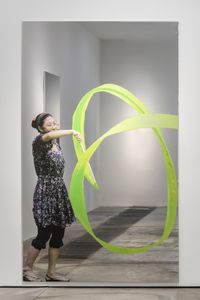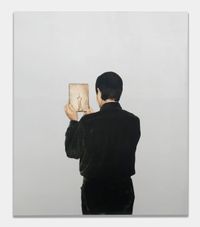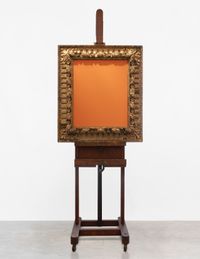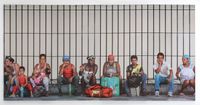A leading figure associated with Italian Art Povera movement, Michelangelo Pistoletto is an influential art theorist, painter, and conceptual artist, known for his performances, mirror paintings and conceptual sculpture.
Read MoreBorn in Biella, Italy in 1933, Pistoletto's artistic training came from working under his father as an art restorer in Turin from 1947 to 1958. In the 1950s he began to paint figurative works and self-portraits, exhibiting in the Biennale di San Marino for the first time in 1959, and in the following year holding his first solo show.
In the 1960s, as his practice developed, Pistoletto subscribed to the basic tenets of Art Povera or 'poor art', a term that encompassed a growing anti-elitist trend at the time of using humble, often ephemeral materials, and 'poor' mediums such as street theatre.
Michelangelo Pistoletto's art reflects the core principles of Art Povera, and the notion of unifying everyday life within art. His polished steel mirror artworks and conceptually driven sculpture and performances explore themes of reflection and the everyday.
Begun in 1962, Pistoletto's 'Quadri specchianti (mirror paintings)' are an enduring and definitive body of work in the artist's long-running practice. Initially painting self-portraits and figurative images on tissue paper that he attached to a highly polished monochrome, metallic background, he later turned to photography and collage, and in the 1970s a process of silkscreen-printing on polished steel mirrors.
By working with a reflective surface, Pistoletto captured the viewer and surrounds within his images, combining art and life literally.
Later variations saw subjects that included, friends, family, and art historical references, and the cropping of figures to create greater dynamism. More recent renditions from the 2000s and onwards have presented objects like shelves of paints, and a bucket and spade, as well as abstract motifs in these mirrored works.
Since the mid-1960s Michelangelo has produced sculpture grounded in the material tenets of Art Povera, incorporating objects and materials from all aspects of life. His earliest body of sculpture 'Minus Objects' (1965-1966), is a series of purposefully unrelated objects made from all sorts of common materials; among them, a newspaper globe surrounded by a wire frame, stained painters suit in vitrine, a rose made from spray-painted corrugated cardboard, and a painted wooden house.
In Pistoletto's Venus of the Rags, appearing in its first form in 1967, the artist combined a classical style Venus sculpture facing a colourful avalanche of discarded rags, that almost swallow the figure. This opposition of culturally valued art objects and discarded everyday material reflects Pistoletto's mission to unify art with everyday life. Versions were repeated to different scales with different materials through the 1960s and 1970s, and in 1980 a version was enacted in San Francisco, performed by a live model.
Performance is another enduring component of Pistoletto's practice. In 1967 Pistoletto founded The Zoo, with then partner Maria Pioppi and other artistic collaborators. The multidisciplinary performance group carried out several 'creative collaborations' between 1968 and 1970.
Performed in the galleries, theatres, city streets, squares, schools, discos and bars of Turin and other cities, the underpinning aim of The Zoo was to include the audience.
From 1979 to 1980, Pistoletto presented performative collaborations in the United States in San Francisco and Athens and Atlanta, Georgia, as well as Opera Ah (1979) performed in Corniglia, Italy with most of the town's residents.
At the 2009 Venice Biennale, Pistoletto presented the performance and installation Twenty-Two Less Two, in which he smashed a series of mirrors leaving marks that became like abstract mirror paintings.
Since 2015, Pistoletto has also enacted several large-scale public performances, based around the concept in three-circle symbol of the Third Paradise. Conceptually this relates to notions of a third stage of humanity based on integration, global cooperation and harmony with technology and nature.
Pistoletto has received numerous prizes and accolades over the years including the Grand Prize at the Biennale of São Paolo (1967), the Golden Lion for Lifetime Achievement at the Venice Biennale (2003), Praemium Imperiale Award from the Japan Arts Association in Tokyo (2013), and Roswitha Haftmann Prize (2018).
Michelangelo Pistoletto has been the subject of both solo exhibition and group exhibitions in museums and galleries worldwide.
Solo exhibitions include Michelangelo Pistoletto, Museo MAC, Santiago, Chile (2018); Michelangelo Pistoletto at Blenheim Palace, Blenheim Palace, Woodstock, UK (2016); Terzo Paradiso, Council of European Union, Brussels (2014); Michelangelo Pistoletto: From One to Many, 1956-1974, Philadelphia Museum of Art, PA (2010); Michelangelo Pistoletto, Musee d'Art Moderne et Art Contemporain, Nice, France (2007); Pistoletto through the mirror, The National Museum of Contemporary Art, Seoul, (1994); Division and Multiplication of the Mirror, MoMA P.S. 1, New York (1988); Michelangelo Pistoletto, International Cultureel Centrum, Antwerp (1979); Michelangelo Pistoletto, Palais des Beaux-Arts, Brussels (1967); A Reflected World, Walker Art Center, Minneapolis (1966).
Group exhibitions include The Paradox of Stillness: Art, Object, and Performance, Walker Art Center, Minneapolis (2021); Plato in L.A. Contemporary Artists's Visions, The J. Paul Getty Museum, Los Angeles (2018); Imagine: New Imagery in Italian Art, 1960—1969, Peggy Guggenheim Collection, Venice (2016); Zero To Infinity: Arte Povera 1962-1972, Tate Modern, London (2001) Pop Art Show, Royal Academy of Arts, London (1991); Aspects of Postwar Painting in Europe and Recent European Painting, Solomon R. Guggenheim Museum, New York (1983); Métamorphose de l'object, Palais des Beaux-Arts, Brussels (1971); Young Italians, Institute of Contemporary Art, Boston (1968); The Object Transformed, The Museum of Modern Art, New York (1966).
Michelangelo Pistoletto's website can be found here.
Michael Irwin Ocula | 2021







